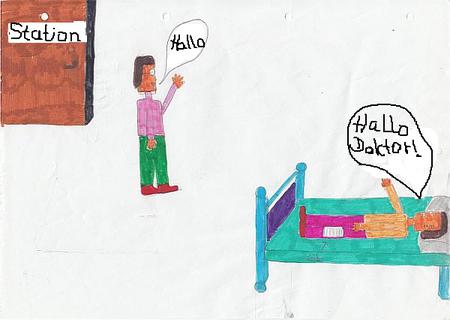Who are all the people on the ward and what do they do?
Author: Gesche Tallen, MD, PhD, Editor: Maria Yiallouros, Reviewer: Prof. Dr. med. U. Creutzig, English Translation: Hannah McRae, Last modification: 2020/05/12 https://kinderkrebsinfo.de/doi/e74064
Table of contents

A child's drawing
The Caregiver Team
Usually, you'll get to know your child's caregiver team gradually. However, if your child is not doing well, you might meet various members of the team all at once. The team typically includes doctors such as pediatric oncologists, surgeons, anesthesiologists, radiation therapists, radiologists, to name a few, as well as educational staff, child psychologists, social workers and physiotherapists.
“Some doctors show up for a while and then you never see them again!” This is a frequent and certainly understandable complaint. However, although unfortunate for patients and their families, high staff turnover is an unevitable routine in large treatment centres in order to maintain optimal medical education. Hence, it may happen that a doctor or a nurse, who has been in charge of your child for a while, will have to rotate to another ward to proceed with the training and thus be "replaced" by someone else. But no worries: every childhood cancer ward also has certain specialists, nurses and other trained, established staff, who are specifically assigned to the pediatric oncology program. Hence, they will not rotate to other wards, but remain your child's caregivers during treatment and aftercare.
Each ward has its own agenda. This means that certain procedures and activities, such as waking up, washing, meals, school, administration of medications, and doctors' rounds take place more or less at fixed times. Usually, patients and their families are getting used to these routines quickly during the first days of their hospital stay.
Medical students, nursing students and other interns and trainees
A center that specializes in treating children and adolescents with cancer is usually either a teaching, such as a university, children's hospital or an institution that is affiliated with one. In other words, it is most likely a hospital where, in addition to examining and treating patients, teaching and research are also part of the daily routine. All this may be confusing at the beginning, since in addition to all the different members of the caregiver team, your child and family will meet medical and nursing students, as well as others, who are on the ward as part of their training, too. But no worries: student's visits will only take place, if your child, you and your caregiver team agree to it based on your child's present physical and mental condition.
Dealing with other patients and families on the ward
There are many children and teenagers on a childhood cancer ward. This, of course, goes along with lots of other parents and family members trying to cope with the burden of their child's disease. As a consequence, many of them team up to share experiences, needs, and concerns. On the one hand, this can be a source of comfort and relief, but on the other, it can cause confusion and distress, for example when you compare the fate of another family to that of your own. To prevent frustration and additional grief, it is important to remember that every child or teenager is different. Hence, her/his individual situation, disease, course of the treatment and family dynamics are hardly comparable to anybody else's.
Many patients and parents benefit from communicating their personal problems as well as coping strategies with their caregiver, in particular their assigned psychosocial team and also from joining established local and national parents' initiatives and communication platforms.
When things don't go swimmingly
Sometimes, life on a hospital ward may not go as swimmingly as desired - neither for your own child, nor for another. The nuances of the underlying problems are sometimes hard to become aware of as an affected patient or family member. For example, there can be days with long waiting times due to an overwhelming number of patients needing care or to shortage of doctors and nurses, respectively. Also, the caregiver team usually strives to take care of the most seriously ill patients first. As a consequence, other patients may sometimes have to wait longer than expected.
Children, teenagers and their families affected by childhood cancer have to cope with many inconveniences that are hard to accept. The caregiver team is there to help. In this context, it is most human to appreciate some doctors and nurses more than others. However, considering yourself as your child's advocate, and the staff as your child's caregivers, there will always be a way of working together toward the common goal of cure.
